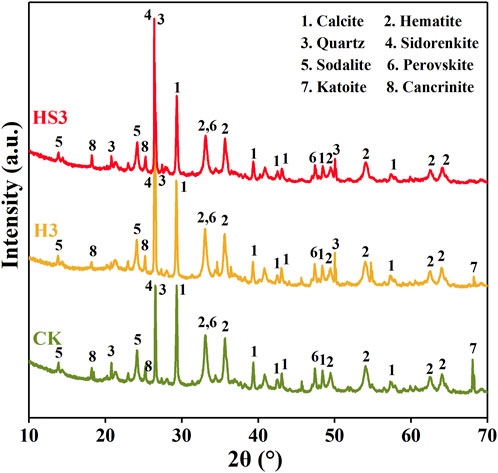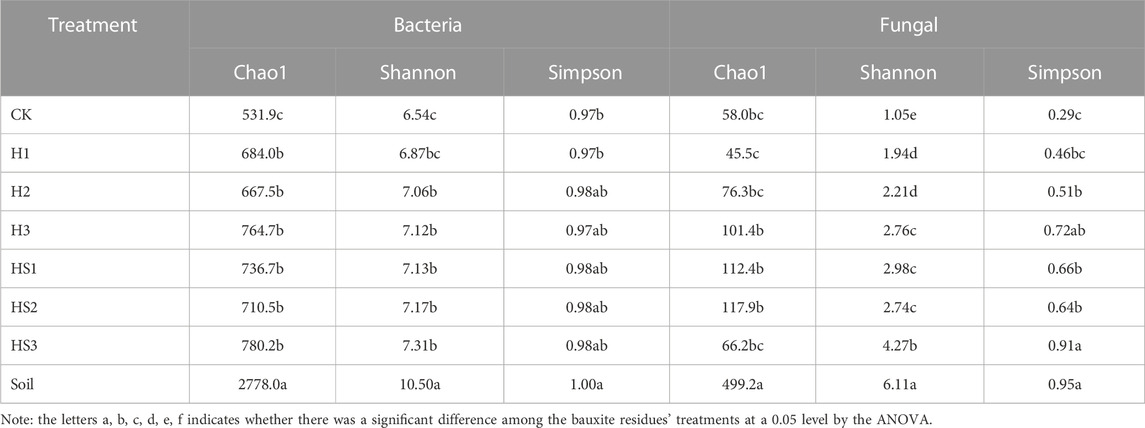- 1School of Agricultural Engineering and Food Science, Shandong University of Technology, Zibo, China
- 2School of Resources and Environmental Engineering, Shandong University of Technology, Zibo, China
- 3School of Life Sciences and Medicine, Shandong University of Technology, Zibo, Shandong Province, China
Introduction: Understanding organic amendment and the agglomeration of bauxite residue particles is vital to soil amelioration of bauxite residues. In this study, a pot culture experiment was conducted to illustrate the aggregation of organic amendment on bauxite residues particles and its improvement mechanism. The single organic amendment and its combination with soil inoculum were conducted to explore the aggregation effect of organic matter on bauxite residue particles, and its correlations with microbial rehabilitation.
Methods: The dry- and wet-sieving method were used to obtain different sizes of aggregates. The concentrations of soil organic carbon and iron and aluminum (Fe/Al) oxides in the forms extractable by DCB (Fed/Ald) and oxalate (Fe0/Al0) were measured. Microbial rehabilitation after 180 days incubation was determined with the methods of Biolog Ecoplate™ and the high-throughput sequencing.
Results and Discussion: The results showed that over 180 days incubation, the alkalinity of bauxite residues was significantly decreased with the organic amendment based on the value of pH, EC and ESP (down to 9.26, 0.61 m/cm and 55.5%, respectively, in HS3). Secondly, organic amendment significantly promoted microbial community establishment and ecological function recovery. Moreover, the MWD value of aggregates also increased to 0.73 mm from the initial 0.32 mm, companied with the increase of the Fe/Al oxidizes. The further Pearson relationship analysis and the characterization of EPMA and SEM indicated that the organic matter and Fe/Al oxides played important roles in cementing fine bauxite residues particles and increasing aggregates stability, while this aggregation process was accelerated by the establishment of microbial ecology in bauxite residues. Therefore, organic amendment was more implication in soil amelioration of bauxite residues other than the directive modifications on alkalinity.
1 Introduction
Aluminum plays a strategic role in economic development and national defense program. The extraction of alumina from bauxite by the Bayer Process is an important process for the production of strategic aluminum (Smart et al., 2016). However, due to the limitation of production technology, a large amount of high alkaline solid waste - bauxite residues is produced during alumina extraction (Kong et al., 2018). Globally, the cumulative inventory of bauxite residue is about 4.60×109 t, and the annual production has reached 2.00×108 t by 2018 (Zhu et al., 2016d; Xue et al., 2016). Moreover, bauxite residues are characterized by strong saline-alkalinity, heavy metals, fine particles size and poor agglomeration, which cause environmental risk to the surrounding environment and life of residents (Higgins et al., 2017; Di Carlo et al., 2020). Recently, increasing investigations proved that the ecological landscape construction with various organic and inorganic amendments was considered a promising approach for the reclamation of bauxite residues on a large scale and to reduce its potential environmental risks (Courtney et al., 2013; Zhu et al., 2016a; Xue, 2019). However, the characteristics of strong alkalinity, poor aggregate structure, and low organic matter content are still the big challenges facing soil amelioration of bauxite residues, which defines the following reclamation of bauxite residues disposal site (Di Carlo et al., 2019b; You et al., 2019).
In practice, soil aggregates are important to ensure that soil remains structured and consistent, which play a key role in soil water and fertilizer conservation, enzyme activity regulation, and air permeability (Wilpiszeski et al., 2019). So that, the aggregation of bauxite residue clays is a key step to promote the soil amelioration of bauxite residue, although the transformation of bauxite residue into a plant-established soil-like medium, also known as bauxite residue soil amelioration, usually undergoes a series of physical, chemical, and biological processes (Goloran et al., 2017; Xue, 2019). In fact, the optimization of the aggregate structure, improvement of organic nutrients, and microbial restoration are all necessary for soil amelioration of bauxite residues (Tian et al., 2020). However, the aggregation of bauxite residue clays, the same to its alkalinity regulation, is a limiting step for the ecological reclamation of bauxite residues (Jones et al., 2012b; Courtney et al., 2013; Xue et al., 2019e). It showed that the natural weathering could improve the physical structure of bauxite residue (Zhu et al., 2016a), with the aggregate formation and plant growth (Santini and Fey, 2013), but this soil amelioration process could be speeded up with some improvement measures (Bray et al., 2018). For example, Zhu et al. (2017) found that the addition of organic matter and Ca2+ can reduce bauxite residue’s pH, promote the formation and stability of macro aggregate particles in the bauxite residue matrix. The single addition of organic matter also could drive the agglomeration of bauxite residue particles, improve the bauxite residue’s structure, and promote microbial rehabilitation and then soil development (Wang et al., 2014; Tian et al., 2020).
In addition, microorganism, as an important part of soil ecosystem, regulating energy flow and material circulation, also plays a key role in soil amelioration of bauxite residue (Ke et al., 2021). It was proved that the rehabilitated microorganisms could produce or excrete various functional metabolites, including organic/inorganic acids, and extracellular polymers, which could neutralize bauxite residues’ alkali and bind fine bauxite residues’ particles into the larger and stable aggregates (Di Carlo et al., 2020; Redmile-Gordon et al., 2020). This is beneficial to regulate the alkalinity and salinity, increase the agglomeration of micro-particles, and lastly promote the rehabilitation of bauxite residue (Xue et al., 2019f; Ke et al., 2021). Previous studies have shown that the assembly and succession of fungal flora in rehabilitated bauxite residue were also driven by the improvement of texture structure and fertility and the decrease of alkalinity of bauxite residue matrix (Dong et al., 2021). Nevertheless, there is still necessary to give more investigation on the comprehensive improvement of organic amendment on the aggregate formation and microbial community restoration in bauxite residue.
The object of this study is to explore the effect of organic matter addition on the agglomeration of bauxite residue particles, and its correlations with microbial rehabilitation during the bauxite residues amelioration process. The pyroligneous acid extracted from corn stalk was chosen as the organic matter amendment, and the campus soil was used as a microbial source. Soil culture experiment was used to evaluate the soil amelioration effect of organic matter on bauxite residue by analyzing the dynamic changes of salinity, aggregate structure, functional microbial community, and other indexes of the improved matrix with different incubation times. We hope to provide theoretical support for the large-scale ecological disposal of bauxite residue by this study.
2 Materials and methods
2.1 Materials preparation and experimental design
The bauxite residue used in this study was provided by the Shandong branch of Chinalco Limited in Zibo, China (118.05686°E, 36.761111°N). The 0–30 cm samples from the bauxite residue disposal site, and transported to the laboratory in polyethylene bags. After natural air-dried, all samples were passed through a 2 mm sieve for the next analysis and cultural experiment. The organic matter extracted from corn stalk, provided by Aoke New Material Technology Company Limited in Shanghai, China, was used as an organic amendment which ingridents were shown in Supplementary Table S1. The surface soil (0–20 cm) of the campus was used as a microbial inoculum added in bauxite residue. The soil was silty loam with pH 8.51, organic matter 57.1 mg/g, and electrical conductivity 0.11 m/cm.
Seven treatments were prepared: 1) CK, unamended bauxite residues; 2) H1, amended with 1% organic matter; 3) H2, amended with 2% organic matter; 4) H3, amended with 3% organic matter; 5) HS1, amended with 1% organic matter and 5% soil; 6) HS2, amended with 2% organic matter and 5% soil; 7) HS3, amended with 3% organic matter and 5% soil. Triplicates were performed for each treatment. All treatments were placed outside in flowerpots (h × ø: 150 mm × 200 mm) with aerated holes at the bottom, cultured outside and irrigated regularly to maintain a humidity (75% or so of the maximum water holding capacity). At 0, 10, 30, and 180 days of incubation, five samples were collected from each pot and mixed as one sample. Each mixed sample was divided into two parts. One part was air-dried for the physical and chemical properties analysis, while the remaining fresh samples were stored at 4°C for microbial analysis.
2.2 Physico-chemical properties analysis
The pH and electrical conductivity (EC) of bauxite residue samples were determined in the extraction solution of deionized water with a solid: liquid ratio of 1:5 (Banning et al., 2014). The organic matter was determined by hydrated heat potassium dichromate oxidation-colorimetric method (Wu et al., 2015). The exchangeable cations (i.e., K+, Na+, Ca2+, and Mg2+) were extracted by 1 M CH3COONH4 (pH 7.0). Free iron oxide (Fed) and free alumina (Ald) were extracted by the dithionite-citrate-bicarbonate (DCB) method, and amorphous iron oxide (Feo) and amorphous alumina (Zhu et al., 2018) were extracted by the ammonium oxalate method (Zhu et al., 2016b). The exchangeable cations and the contents of the iron and aluminum oxide in the solution were determined using an Inductively coupled plasma atomic emission spectrometer (ICP-AES, Optima 5300DV, Perkin Elmer). In addition, the cation exchange capacity (Nannipieri et al., 2003) is calculated using the sum of exchangeable cations, and the exchangeable sodium percentage (Vázquez et al., 2020) was calculated by the percentage of exchangeable Na+ content in total exchangeable cations (Zhu et al., 2016c; Li et al., 2018).
2.3 Microbial community diversity and functional analysis
Biolog EcoPlate™ (Biolog Inc., Hayward, CA, United States) was used to measure the microbial community level physiological profiles (CLPP), and the absorbance data of the plate were measured regularly every 12 h at 590 nm for 7 days. Then the average well color development (AWCD) and microbial functional diversity indexes (Shannon-Wiener (H’) and Simpson (D)) were calculated (Feigl et al., 2017).
Microbial community composition and diversity were determined by the high-throughput sequencing. Use the E.Z.N.A. ®Stool DNA Kit (D4015, Omega, Inc., United States ) to extract bacterial and fungal DNA from bauxite residue samples according to the instructions. The V3-V4 region of bacterial 16S rDNA was amplified by the polymerase chain reaction (PCR), and the primer sequences were 341F (5′-CCTACGGGNGGCWGCAG-3′) and 805R (5′-GACTACHVGGGTATCTAATCC-3′). The ITS1 gene was amplified by the PCR with primers fITS7 (5′-GTGART-CATCGAATCTTTG-3′) and ITS4 (5′-TCCTCCGCT-TATTGATATG-3′). The purification and recycling of the PCR products were conducted with AMPure XT beads (Beckman Coulter Genomics, Danvers, MA, United States ). And then, Qubit® 2.0 DNA kit was used to accurately quantify the DNA obtained. Illumina Hiseq/Miseq PE300 sequence platform (provided by Hangzhou Lianchuan Biotechnology Co., LTD.) was used for the sequencing analysis of the obtained DNA. High quality sequences were obtained by splicing, filtering, eliminating chimera, and discarding low quality sequences, and used for classification of the operational taxon (OTU), diversity index calculation, and species abundance analysis.
2.4 Aggregate stability analysis
The distribution of aggregates particles size was determined by dry and wet sieving methods respectively (Le Bissonnais, 1996). The mean weight diameter (MWD), geometric mean diameter (GMD), and the proportion of aggregate destruction (PAD) were selected as parameters to evaluate the aggregate stability of bauxite residue. The calculation formulas are as follows:
Where, Xi is the mean diameter over each particle-size (mm), Wi is the percentage of aggregates in that size range (Six et al.), n is the number of sieves, Wd is the proportion of >0.25 mm aggregates in dry sieving (Six et al.), Ww is the proportion of >0.25 mm aggregates in wet sieving (Six et al.).
2.5 Morphological and mineral composition analysis
Scanning electron microscopy (SEM, Quanta 200 FEG, FEI, American) and electron probe micro-analyzer (EPMA, Oxford INCA Energy 350, United Kingdom) were used to reveal the microstructure and element distribution of different bauxite residue treatments. The mineral composition of different bauxite residue samples was analyzed by X-ray diffraction (XRD, D8 Advance, Bruker, German).
2.6 Data analysis
All raw data were calculated in Microsoft Excel 2019. One-way analyses of variance (ANOVAs) for different treatments using SPSS 19.0. Redundancy analyses (RDAs) were analyzed using Canoco 5. All figures were drawn using Origin 8.0.
3 Results
3.1 Improvement on residues properties
The strong alkalinity, high salt content and nutrient deficiency are the key factors restricting the ecological large-scale disposal of bauxite residues (Wu et al., 2021). As shown in Figures 1A,B, organic amendment process significantly mitigated the alkalinity and salty of bauxite residues as the pH and EC in each amended treatment were lowered compared to the CK treatment, and over 180 days incubation, they were respectively down to 9.26 and 0.61 m/cm in HS3 treatments. However, no significant decrease in ESP was not determined as the organic amendment when compared the CK treatments, although over 180 days incubation the ESP was significantly decreased in each the treatment (Figure 1C). Finally, with the organic amendment, the total organic carbon increased significantly in each organic amended treatments, and it was even up 66.51 mg/kg in HS3 treatment (Figure 1D). Whatever, in comparison, the combined improvement of organic amendment and soil inoculum on bauxite residues is better than that of the single organic amendment, though there was still not rehabilitated to the level of the natural soils.
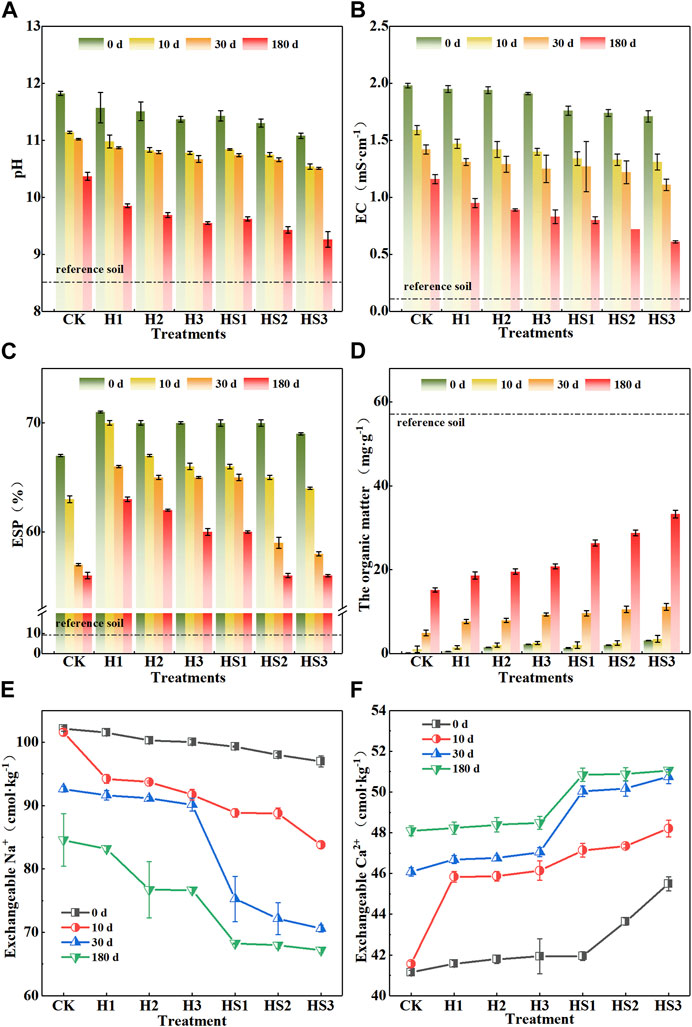
FIGURE 1. Physico-chemical characteristics of different bauxite residue samples (A), pH; (B), EC; (C), ESP; (D), the organic matter; (E), exchangeable Na+ content; (F), exchangeable Ca2+ content.
Different from ESP, organic amendment significantly decreased the content of exchangeable Na+, and it was down to 67.17 cmol/kg in HS3 after 180 days incubation. In addition, the content of exchangeable Ca2+ showed a continuous increase with the incubation extension, especially in the organic amended treatment. For example, the concentration of exchangeable Ca2+ increased from the initial 41.14 cmol/kg to 51.06 cmol/kg in HS3 over 180 days incubation. Moreover, the further XRD analysis indicated that the peak of the alkali mineral phases, such as Calcite (CaCO3) and Katoite (Ca3Al2(SiO4) (OH)4) decreased significantly both in Hs and HS3 treatments (Figure 2). That is, it could speculate that organic amendment decreased the pH, which led to the release of Ca2+ from Calcite (CaCO3) and Katoite, etc., the alkali mineral phase. The released Ca2+ can not only precipitate with the basic anions of bauxite residue, but also exchange with the bound Na+ by the bauxite residue particles, which in turn effectively improved the alkalinity of bauxite residues (Xue et al., 2019d).
3.2 Restoration of microbial function and community diversity
The changes of microbial functional diversity in amended bauxite residue were measured by using the community level physiological profile at 0 and 180 days of incubation (Table 1). The microbial activity of fresh bauxite residue was low as the AWCD value was only 0.02. After 180 days incubation, the AWCD and the diversity index (H′ and D), indicating microbial function diversity, were significantly (p < 0.05) higher in each amended treatment than those of CK (Table 1), and in the HS treatments, the values of AWCD and H’ index was up to 1.12 and 3.21 respectively, which also significantly higher than the single organic amended treatments. It suggested that the co-addition of soil inoculum was more beneficial to microbial function recovery than the single organic amendment.
The further high-throughput sequencing analysis indicated that organic amendment promotes the rehabilitation of microbial community. Firstly, over 180 days incubation, whatever for bacteria or fungal community, the Chao1 index in organic amended treatments were all significantly (p < 0.05) higher than that of CK treatment (Table 2), indicated that organic amendment could significantly improve microbial community richness of bauxite residues, although there was still far from the microbial community richness of natural soils. Moreover, in most cases, the Shannon index or Simpson index in the organic amended treatments were significantly from that in the CK treatment, indicated that a significant increase of microbial community diversity in bauxite residues as the organic amendment. It suggested that organic amendment could make bauxite residues suitable for the colonization of various microorganism. However, different from the improvement effect on the physical and chemical properties of bauxite residues, the promotion of organic amendment and soil inoculum was not significantly better than the single organic amendment for bacterial or fungal community colonization in bauxite residues, according to their indexes of Chao1, Shannon and Simpson (Table 2).
Cluster analysis was performed on the 10 most abundant bacterial and fungal genera in each treatment (Figure 3). The different community composition in bacteria and fungi was determined between the organic amended treatments and the CK treatment. Moreover, in contrast to CK treatment, the abundance of Bacillus, Halomonas, Egicoccus, and Nitriliruptor, which are all halotolerant or halophilic to the high salinity-alkali environment (Zhao et al., 2022), were decreased, while some acidogenic strains, such as Pseudomonas, Acidobacteria_unclassified, and Acremonium (Schmalenberger et al., 2013), were increased in the amendment treatments. In short, as the increase of added organic matter, cluster analysis indicated that bacterial and fungal composition at the genus level in the bauxite residue became gradually closer to that of the reference soil (Figure 3).
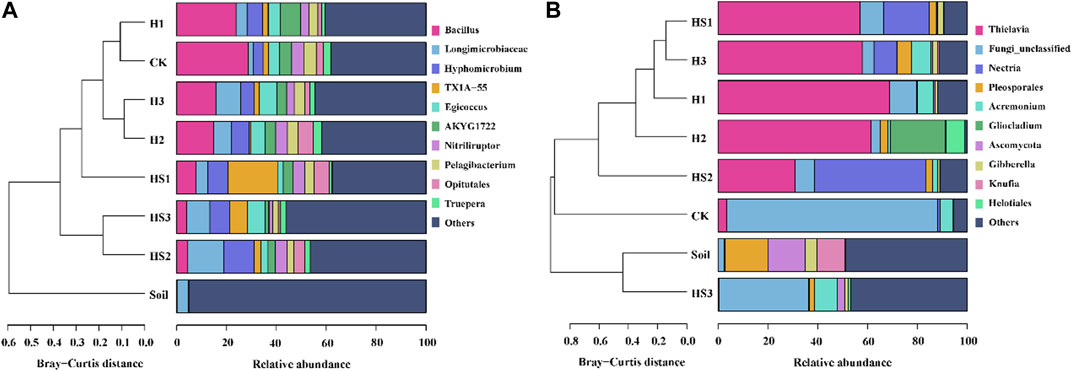
FIGURE 3. Cluster analysis of community compositions of (A) bacteria and (B) fungi based on the relative abundance.
3.3 Aggregate size distribution and aggregate stability
Iron and aluminum oxides and organic matter are the basic components of soil complex, which can significantly affect soil structure and aggregates composition through cementation (Six et al., 2004). So that, to illustrate the improvement effect of organic amendment on the aggregation of bauxite residues particles, the present study determined the content of free and amorphous iron and aluminum oxides between the different bauxite residues treatments and their variation along the incubation (Figure 4). As shown in Figures 4A,C, in most cases, organic amendment increased the content of iron and aluminum oxides, especially for the free iron and aluminum oxides, which showed a significantly increase with organic amendment and it was particularly significant over 180 days incubation. However, no significant increase was almost not determined for amorphous iron and alumina with the amendment of organic matter, although there was an obvious increase in most treatments after 180 days incubation (Figures 4B,D).
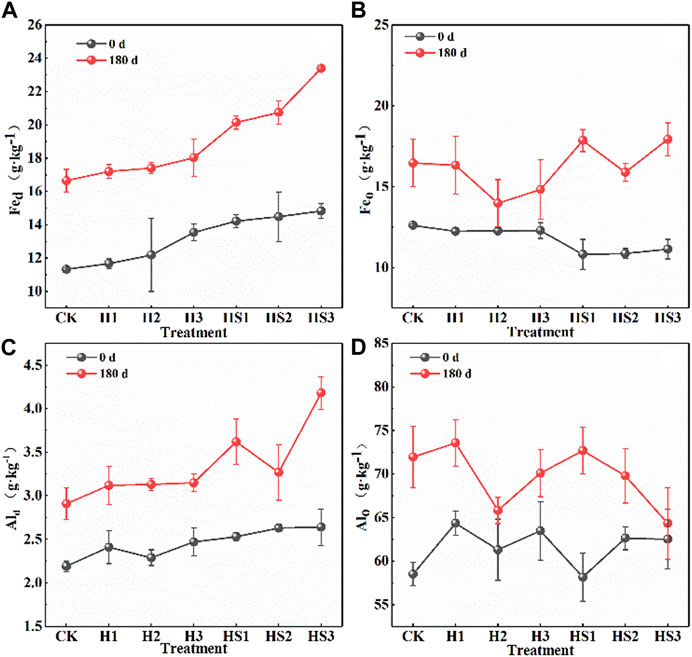
FIGURE 4. Iron-aluminium oxide contents in bauxite residue samples (A), Fed content; (B), Feo content; (C), Ald content; (D), Alo content.
Accordingly, the aggregation effect of organic amendment on bauxite residues particles was observed in different treatments at each incubation stage (Figure 5). Based on the dry sieve analysis of aggregates, the proportion of >0.25 mm aggregates increased, whilst it decreased markedly for the component of <0.25 mm aggregates, especially for those of <0.05 mm micro-aggregates, in each organic amended treatment; In addition, under wet sieving, the proportion of >0.05 mm aggregates with water stability also increased markedly, especially for macro-aggregates of 1–2 mm. That is, in the CK treatment the aggregates of <0.05 mm accounted for 65.86%, while in the organic amendment treatments, the proportion of 1–2 mm and 0.05–0.25 mm aggregates in HS3 treatment increased to 11.54% and 36.26%, respectively. Moreover, as shown in Figure 6A-C, the MWD and GMD of bauxite residue particles, whatever calculated according to the dry or the wet sieve analysis, all showed a markable increase with the amendment of organic matter and soil inoculum; and with the incubation extension, they increased up to 0.73 mm (MWDd), 0.37 mm (MWDw) and 0.16 mm (GMD). In addition, after 180 days incubation, the PAD of the aggregates in organic amended treatments showed a markable decrease comparted to the CK treatment (Figure 6D). The results showed that the addition of organic matter had an improvement on aggregation of bauxite residues as well as the water stability of the aggregates, and this improvement with the co-addition of soil inoculum was more significant for the water stability of aggregates.
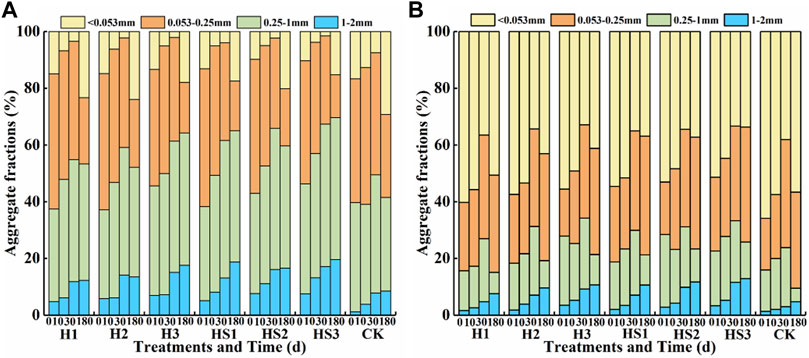
FIGURE 5. Percentage distribution (%) of aggregate sizes (mm) in different residue samples (A), dry sieving; (B), wet sieving.
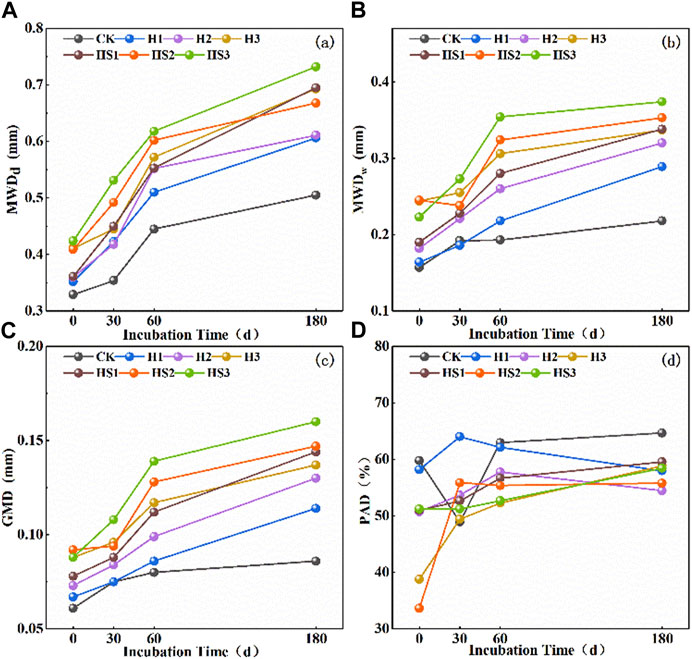
FIGURE 6. Changes in aggregate stability of the treated residues following amendment additions (A), MWDd under dry sieving; (B), MWDw under wet sieving; (C), GMD; (D), PAD in different residue samples.
3.4 Aggregation mechanism of bauxite residue particles
As shown in Figures 6A,B, the distribution of the element Na was distinctly reduced while Ca elements was obviously increased on the particles’ surface of the HS3 treatments compared with CK treatment. This is well agreed with the results of the exchange Na+ and Ca2+ (Figures 1E,F) and the XRD results that the peak of the mineral phase Calcite and Katoite decreased in bauxite residues as the organic amendment (Figure 2). Moreover, the EMPA images also indicated that Na was evenly distributed in small particles, while Ca was distributed in large particles (Figures 6A,B). This result might suggest that the increased Ca promoted the aggregation of bauxite residue particles. As for the distribution images of the elements Fe and Al (Figures 6A,B), there was a clear increase with organic amendments (HS3) in contrast to the CK treatment. This is the same to the results of Fe-Al oxides analysis (Figure 4). At the same time, the elements of Al and Fe were more densely distributed on the large aggregates of bauxite residues, especially after treated with organic amendment (Figure 6B), which suggested that organic amendment could promote the formation of the aggregate through the cementation of Fe-Al oxides. The further correlation analysis also proved that the Fe-Al oxides and organic carbon had positive relationships with the aggregates size over >1mm, while were negatively relative to the PAD of aggregates (Supplementary Figure S2).
Figure 6C showed the morphology of bauxite residue particles in different treatments over a 180 days incubation. As shown in Figure 6C, in the unamended bauxite residues (CK), it has a loose microstructure and mainly consists of fine particles and detritus; while for the H3 treatment with a single organic amendment, the flocculation of bauxite residue particles was distinctive in contrast to the CK treatment as the loose large particles became the main component of bauxite residues matrix. Moreover, in HS3 treatment with the organic amendment and soil inoculum, the bauxite residue aggregates began to appear obvious flake structure, and its texture became denser in contrast to the H3 treatments, which was called the formation of large aggregates and began to appear soil-like structure (Li et al., 2019). This gradual improvement in bauxite residues’ aggregates from the CK to the H3 and then HS3 suggested that microbial community should play an important role on the agglomeration of bauxite residue particles by the entanglement of hyphae, when considering the closer fungal composition between the HS3 treatments and the reference soils (Figure 3B).
4 Discussion
Despite high alkalinity, the soil amelioration of bauxite residues are also restricted by fine powder particles and poor fertility (Xue et al., 2019c). Therefore, the formation of stable aggregates and accumulation of organic matter were considered to be a key step to the soil amelioration of bauxite residues and the subsequent successful establishment of ecological system (Courtney et al., 2014b). Organic amendment was proved effective to improve the matrix structure of bauxite residues by increasing porosity, and improving aggregate stability (Jones et al., 2012a; Courtney et al., 2013). But few studies illustrated the improvement mechanism of organic amendments on bauxite residues. In the present study, we mainly investigated the promotion of organic amendments on the agglomeration of bauxite residue particles and its possible mechanisms.
Firstly, organic amendment in the present study effectively decreased pH, EC, and ESP of bauxite residue, especially with incubation extension (Figures 1A–C), which is similar to the previous studies (Banning et al., 2011; Haynes and Zhou, 2019). As all known, the high alkalinity and salinity is not a big obstacle to the rehabilitation of bauxite residues (Ruyters et al., 2011; Anam et al., 2019), but also causes great problems on the agglomeration of bauxite residue particles, as the highly active Na+ could cause the dispersion of the colloidal double layer, and lead to the disintegration of aggregates and the dispersion of clay particles (Kong et al., 2017). At the same time, we determined a more significant decrease of exchangeable Na+ in bauxite residues with the organic amendment and the distinct increase of exchangeable Ca2+ (Figures 1E,F) as well as the changes in mineral phases of bauxite residues (Figure 2). It was proved that the small organic acids from the organic amendment biodegradation could accelerate the dissolution of the alkaline minerals, including Calcite (CaCO3) and Katoite (Ca3Al2(SiO4) (OH)4), in the bauxite residues (Di Carlo et al., 2019a; Di Carlo et al., 2019b), and resulted in the increase of the exchangeable Ca2+, which is beneficial to the aggregation of the fine bauxite residues clays as the clay absorbed Na+ is removed by the exchanger of Ca2+ (Power et al., 2011; Gupta et al., 2019). In the present study, according to the changes of the exchangeable Na+ and Ca2+ with organic amendment and over incubation (Figures 1E,F) as well as the results of XRD (Figure 2), the similar process should have occurred as the organic amendment has various organic acids (Supplementary Table S1), too.
Microorganisms are thought to play important roles in cementing different particles into through the cementing, winding, and wrapping of metabolites (such as extracellular polymers, polysaccharides, etc.), mycelium, and dead cells debris (Santini et al., 2015b). Beside of the improvement on bauxite residues’ properties, the organic amendment can also increase the nutrient content of the bauxite residue matrix, and then accelerated the colonization of some pioneer microbial strains as well as the further microbial community establishment in the amended bauxite residues (Santini et al., 2015a; Bray et al., 2018), (Courtney et al., 2014a; Yang et al., 2020). In the present study, in contrast to the CK treatment, a significant increase was also found in microbial functional activities (Table 1) and communities’ richness and diversity for the organic amendment treatments, especially after 180 days incubation (Table 2). Moreover, with the organic amendment, some reported pioneer organisms, such as the halophilic alkalophilic bacteria Ascomycota, Basidiomycota, Actinomycota, Proteobacteria, and Bacillus (Liu et al., 2014; Dong et al., 2021), decreased over incubation, and the appearance of some acidogenic organisms, such as Pseudomonas, Acidobacteria_unclassified, and Acremonium (Schmalenberger et al., 2013), compared to the CK treatments. Villar et al. (2004) found that the polysaccharide secreted by microorganisms and the winding effect of fungal hyphae made soil particles better aggregate. Studies had shown that microbial decomposition of organic matter produced polysaccharides, which could effectively cemented bauxite residue particles by ionic and hydrogen bonds of free hydroxyl groups (Santini et al., 2015b). So that, stimulating microbial rehabilitation in bauxite residues should be an effective way for organic amendment to promote the agglomeration of bauxite residue particles. This could be proved by the closer bacterial and fungal flora to the reference soils (Figure 3B), companied with the appearance of the soil-like large aggregates in the HS3 treatments (Figure 7B). Qu et al. (2019) found that bacteria and fungi could dissolve the fine particles (mainly iron oxide) in bauxite residue, producing the layered structure of bauxite residue.
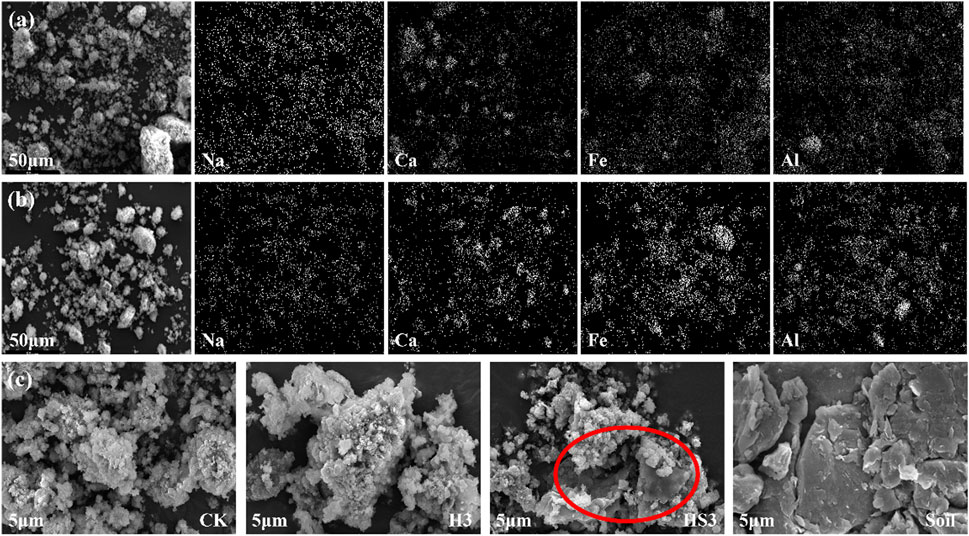
FIGURE 7. The morphology of (C) different treatments and elemental mapping images of (A) CK and (B) HS3.
Soil organic carbon and Fe/Al oxides are the main cementing agents in the formation of soil aggregates (Xue et al., 2019a; Xue et al., 2019b). A significant increase of the total organic carbon and Fe/Al oxides occurred in the organic amended treatments in contrast to the CK treatment (Figure 4), which was all proved to be positive relationship with the aggregates size over >1mm, and negatively relative to the PAD of aggregates (Supplementary Figure S2). This result agreed with the previous studies that the cohesion between aggregates from the SOC and Fe/Al oxides could reduce the breakdown of hydraulic and air pressures to aggregates (Zhao et al., 2017; Pituello et al., 2018; Du et al., 2022). In addition, companied with the transform of the aggregates’ morphology from the loose microstructure (CK) to a soil-like structure appearance (HS3) (Figure 7C), there was a markable increase for the distribution of Ca, Fe and Al elements on the aggregate surface (Figures 7A,B). It showed that Ca2+ had a good affinity with the soil colloidal surface, which could reduce the dispersion of clays, and promote the flocculation and stability of aggregates (Harris and Rengasamy, 2004; Xue et al., 2021). So that, beside of the directive cohesion between aggregates, Increasing the level of Fe/Al oxides and Ca2+ also is principal way for organic amendment to promote the aggregation of fine bauxite residue particles.
5 Conclusion
In the present study, the aggregation effect of organic matter on bauxite residue was investigated with a pot experiment. It was found that, in addition to the improvement on the alkalinity and the promotion on microbial recovery, the proportion and size of bauxite residues’ aggregates were significantly increased with organic amendments. Moreover, the further analysis of Fe/Al oxides, EMPA characterization as well as the micromorphology showed that beside of the directive cohesion between aggregates, the increase of Ca2+ and Fe/Al oxides should play important roles in the improvement of organic amendment on the agglomeration of bauxite residue particles; and the rehabilitation of microbial community and ecological function could accelerate the large aggregates formation in the organic amended bauxite residues. Based on this study, it could be seen that organic matter amendment was an effective measure for the improvement of bauxite residues aggregates formation.
Data availability statement
The original contributions presented in the study are included in the article/Supplementary Materials, further inquiries can be directed to the corresponding authors.
Author contributions
MD: Data curation, Writing-original draft. ZW, English improvement and modification; GW, JL, GH, XG, LC and FR: Visualization and Investigation. KL, YX, and ML: Reviewing and Validation. HL: Visualization and Editing. AL: Conceptualization, Methodology. All authors contributed to the article and approved the submitted version.
Funding
The work was supported by the National Natural Science Foundation of China (NSFC) under Grant No. 42077129, No.42177403 and No. 41877122; and Natural Science Foundation of Shandong Province under Grant No. ZR2020ZD19 and No. ZR2022YQ34.
Conflict of interest
The authors declare that the research was conducted in the absence of any commercial or financial relationships that could be construed as a potential conflict of interest.
Publisher’s note
All claims expressed in this article are solely those of the authors and do not necessarily represent those of their affiliated organizations, or those of the publisher, the editors and the reviewers. Any product that may be evaluated in this article, or claim that may be made by its manufacturer, is not guaranteed or endorsed by the publisher.
Supplementary material
The Supplementary Material for this article can be found online at: https://www.frontiersin.org/articles/10.3389/fenvs.2023.1154191/full#supplementary-material
References
Anam, G. B., Reddy, M. S., and Ahn, Y. H. (2019). Characterization of Trichoderma asperellum RM-28 for its sodic/saline-alkali tolerance and plant growth promoting activities to alleviate toxicity of red mud. Sci. Total Environ. 662, 462–469. doi:10.1016/j.scitotenv.2019.01.279
Banning, N. C., Phillips, I. R., Jones, D. L., and Murphy, D. V. (2011). Development of microbial diversity and functional potential in bauxite residue sand under rehabilitation. Restor. Ecol. 19, 78–87. doi:10.1111/j.1526-100x.2009.00637.x
Banning, N. C., Sawada, Y., Phillips, L. R., and Murphy, D. V. (2014). Amendment of bauxite residue sand can alleviate constraints to plant establishment and nutrient cycling capacity in a water-limited environment. Ecol. Eng. 62, 179–187. doi:10.1016/j.ecoleng.2013.10.034
Bray, A., Stewart, D., Courtney, R., Rout, S., Humphreys, P., Mayes, W., et al. (2018). Sustained bauxite residue rehabilitation with gypsum and organic matter 16 years after initial treatment. Environ. Sci. Technol. 52, 152–161. doi:10.1021/acs.est.7b03568
Courtney, R., Feeney, E., and O’Grady, A. (2014a). An ecological assessment of rehabilitated bauxite residue. Ecol. Eng. 73, 373–379. doi:10.1016/j.ecoleng.2014.09.064
Courtney, R., Harrington, T., and Byrne, K. A. (2013). Indicators of soil formation in restored bauxite residues. Ecol. Eng. 58, 63–68. doi:10.1016/j.ecoleng.2013.06.022
Courtney, R., Harris, J. A., and Pawlett, M. (2014b). Microbial community composition in a rehabilitated bauxite residue disposal area: A case study for improving microbial community composition. Restor. Ecol. 22, 798–805. doi:10.1111/rec.12143
Di Carlo, E., Boullemant, A., and Courtney, R. (2019a). A field assessment of bauxite residue rehabilitation strategies. Sci. Total Environ. 663, 915–926. doi:10.1016/j.scitotenv.2019.01.376
Di Carlo, E., Boullemant, A., and Courtney, R. (2020). Ecotoxicological risk assessment of revegetated bauxite residue: Implications for future rehabilitation programmes. Sci. Total Environ. 698, 134344. doi:10.1016/j.scitotenv.2019.134344
Di Carlo, E., Chen, C., Haynes, R., Phillips, I., and Courtney, R. (2019b). Soil quality and vegetation performance indicators for sustainable rehabilitation of bauxite residue disposal areas: A review. Soil Res. 57, 419–446. doi:10.1071/sr18348
Dong, M., Shao, Y., Xu, Z., Liu, X., Xu, Y., Hu, X., et al. (2021). Resilience of fungal flora in bauxite residues amended with organic matter and vermiculite/fly ash. J. Environ. Manage. 284, 112052. doi:10.1016/j.jenvman.2021.112052
Du, J., Liu, K., Huang, J., Han, T., Zhang, L., Anthonio, C. K., et al. (2022). Organic carbon distribution and soil aggregate stability in response to long-term phosphorus addition in different land-use types. Soil Tillage Res. 215, 105195. doi:10.1016/j.still.2021.105195
Feigl, V., Ujaczki, E., Vaszita, E., and Molnar, M. (2017). Influence of red mud on soil microbial communities: Application and comprehensive evaluation of the Biolog EcoPlate approach as a tool in soil microbiological studies. Sci. Total Environ. 595, 903–911. doi:10.1016/j.scitotenv.2017.03.266
Goloran, J. B., Phillips, I. R., and Chen, C. (2017). Forms of nitrogen alter plant phosphorus uptake and pathways in rehabilitated highly alkaline bauxite processing residue sand. Land Degrad. Dev. 28, 628–637. doi:10.1002/ldr.2630
Gupta, P., Couperthwaite, S. J., Santini, T. C., Pepper, R. A., and Millar, G. J. (2019). Experimental and geochemical modelling investigations on the weathering behaviour of bauxite residue: Effect of pH. J. Environ. Chem. Eng. 6, 103509. doi:10.1016/j.jece.2019.103509
Harris, M. A., and Rengasamy, P. (2004). Sodium affected subsoils, gypsum, and green-manure: Inter-actions and implications for amelioration of toxic red mud wastes. Environ. Earth Sci. 45, 1118–1130. doi:10.1007/s00254-004-0970-y
Haynes, R., and Zhou, Y. F. (2019). Natural ripening with subsequent additions of gypsum and organic matter is key to successful bauxite residue revegetation. J. Cent. South Univ. 26, 289–303. doi:10.1007/s11771-019-4001-2
Higgins, D., Curtin, T., and Courtney, R. (2017). Effectiveness of a constructed wetland for treating alkaline bauxite residue leachate: A 1-year field study. Environ. Sci. Pollut. Res. 24, 8516–8524. doi:10.1007/s11356-017-8544-1
Jones, B. E. H., Haynes, R. J., and Phillips, I. R. (2012a). Addition of an organic amendment and/or residue mud to bauxite residue sand in order to improve its properties as a growth medium. J. Environ. Manage. 95, 29–38. doi:10.1016/j.jenvman.2011.09.014
Jones, B. E. H., Haynes, R. J., and Phillips, I. R. (2012b). Addition of an organic amendment and/or residue mud to bauxite residue sand in order to improve its properties as a growth medium. J. Environ. Manag. 95, 29–38. doi:10.1016/j.jenvman.2011.09.014
Ke, W., Zhang, X., Zhu, F., Wu, H., Zhang, Y., Shi, Y., et al. (2021). Appropriate human intervention stimulates the development of microbial communities and soil formation at a long-term weathered bauxite residue disposal area. J. Hazard. Mater. 405, 124689. doi:10.1016/j.jhazmat.2020.124689
Kong, X., Li, M., Xue, S., Hartley, W., Chen, C., Wu, C., et al. (2017). Acid transformation of bauxite residue: Conversion of its alkaline characteristics. J. Hazard. Mater. 324, 382–390. doi:10.1016/j.jhazmat.2016.10.073
Kong, X., Tian, T., Xue, S., Hartley, W., Huang, L., Wu, C., et al. (2018). Development of alkaline electrochemical characteristics demonstrates soil formation in bauxite residue undergoing natural rehabilitation. Land Degrad. Dev. 29, 58–67. doi:10.1002/ldr.2836
Le Bissonnais, Y. (1996). Aggregate stability and assessment of soil crustability and erodibility: I. Theory and methodology. Eur. J. Soil Sci. 67, 11–21. doi:10.1111/ejss.4_12311
Li, Y., Haynes, R. J., Chandrawana, I., and Zhou, Y. F. (2018). Properties of seawater neutralized bauxite residues and changes in chemical, physical and microbial properties induced by additions of gypsum and organic matter. J. Environ. Manage. 223, 489–494. doi:10.1016/j.jenvman.2018.06.070
Li, Y. W., Luo, X. H., Li, C. X., Millar, G. J., Li, X. H., and Xue, S. g. (2019). Variation of alkaline characteristics in bauxite residue under phosphogypsum amendment. J. Central South Univ. 26, 361–372. doi:10.1007/s11771-019-4008-8
Liu, K., Ding, X., Wang, H. F., Zhang, X., Hozzein, W. N., Wadaan, M. A. M., et al. (2014). Eukaryotic microbial communities in hypersaline soils and sediments from the alkaline hypersaline Huama Lake as revealed by 454 pyrosequencing. Antonie Leeuwenhoek 105, 871–880. doi:10.1007/s10482-014-0141-4
Nannipieri, P., Ascher, J., Ceccherini, M. T., Landi, L., Pietramellara, G., and Renella, G. (2003). Microbial diversity and soil functions. Eur. J. Soil Sci. 54, 655–670. doi:10.1046/j.1351-0754.2003.0556.x
Pituello, C., Dal Ferro, N., Francioso, O., Simonetti, G., Berti, A., Piccoli, I., et al. (2018). Effects of biochar on the dynamics of aggregate stability in clay and sandy loam soils. Eur. J. Soil Sci. 69, 827–842. doi:10.1111/ejss.12676
Power, G., GräFe, M., and Klauber, C. (2011). Bauxite residue issues: I. Current management, disposal and storage practices. Hydrometallurgy 108, 33–45. doi:10.1016/j.hydromet.2011.02.006
Qu, Y., Li, H., Wang, X., Tian, W., Shi, B., Yao, M., et al. (2019). Bioleaching of major, rare earth, and radioactive elements from red mud by using indigenous chemoheterotrophic bacterium acetobacter sp. Minerals 9, 67. doi:10.3390/min9020067
Redmile-Gordon, M., Gregory, A., White, R., and Watts, C. (2020). Soil organic carbon, extracellular polymeric substances (EPS), and soil structural stability as affected by previous and current land-use. Geoderma 363, 114143. doi:10.1016/j.geoderma.2019.114143
Ruyters, S., Mertens, J., Vassilieva, E., Dehandschutter, B., Poffijn, A., and Smolders, E. (2011). The red mud accident in ajka (Hungary): Plant toxicity and trace metal bioavailability in red mud contaminated soil. Environ. Sci. Technol. 45, 1616–1622. doi:10.1021/es104000m
Santini, T. C., and Fey, M. V. (2013). Spontaneous vegetation encroachment upon bauxite residue (red mud) as an indicator and facilitator of in situ remediation processes. Environ. Sci. Technol. 47, 12089–12096. doi:10.1021/es402924g
Santini, T., Kerr, J., and Warren, L. (2015a). Microbial diversity in engineered haloalkaline environments shaped by shared geochemical drivers observed in natural analogues. Appl. Environ. Microbiol. 81, 5026–5036. doi:10.1128/aem.01238-15
Santini, T., Kerr, J., and Warren, L. (2015b). Microbially-driven strategies for bioremediation of bauxite residue. J. Hazard. Mater. 293, 131–157. doi:10.1016/j.jhazmat.2015.03.024
Schmalenberger, A., Osullivan, O., Gahan, J., Cotter, P. D., and Courtney, R. (2013). Bacterial communities established in bauxite residues with different restoration histories. Environ. Sci. Technol. 47, 7110–7119. doi:10.1021/es401124w
Six, J., Bossuyt, H., Degryze, S., and Denef, K. J. S. (2004). A history of research on the link between (micro) aggregates, soil biota, and soil organic matter dynamics. Soil tillage Res. 79, 7–31. doi:10.1016/j.still.2004.03.008
Smart, D., Callery, S., and Courtney, R. (2016). The potential for waste-derived materials to form soil covers for the restoration of mine tailings in Ireland. Land Degrad. Dev. 27, 542–549. doi:10.1002/ldr.2465
Tian, T., Liu, Z., Zhu, F., Hartley, W., Ye, Y., and Xue, S. (2020). Improvement of aggregate-associated organic carbon and its stability in bauxite residue by substrate amendment addition. Land Degrad. Dev. 31, 2405–2416. doi:10.1002/ldr.3609
Vázquez, E., Benito, M., Espejo, R., and Teutscherova, N. (2020). Response of soil properties and microbial indicators to land use change in an acid soil under Mediterranean conditions. CATENA 189, 104486. doi:10.1016/j.catena.2020.104486
Villar, M., Petrikova, V., Dıaz-Ravina, M., and Carballas, T. (2004). Changes in soil microbial biomass and aggregate stability following burning and soil rehabilitation. Geoderma 122, 73–82. doi:10.1016/j.geoderma.2003.12.005
Wang, C., Tu, Q., Dong, D., Strong, P. J., Wang, H., Sun, B., et al. (2014). Spectroscopic evidence for biochar amendment promoting humic acid synthesis and intensifying humification during composting. J. Hazard. Mater. 280, 409–416. doi:10.1016/j.jhazmat.2014.08.030
Wilpiszeski, R. L., Aufrecht, J. A., Retterer, S. T., Sullivan, M. B., Graham, D. E., Pierce, E. M., et al. (2019). Soil aggregate microbial communities: Towards understanding microbiome interactions at biologically relevant scales. Appl. Environ. Microbiol. 85, e00324–e00319. doi:10.1128/aem.00324-19
Wu, C., Xia, J., and Duan, Z. (2015). Review on detection methods of soil organic matter(SOM). Soils 47, 453–460.
Wu, H., Tang, T., Zhu, F., Wei, X., and Xue, S. (2021). Long term natural restoration creates soil-like microbial communities in bauxite residue: A 50-year filed study. Land Degrad. Dev. 32, 1606–1617. doi:10.1002/ldr.3728
Xue, B., Huang, L., Huang, Y., Yin, Z., Li, X., and Lu, J. (2019a). Effects of organic carbon and iron oxides on soil aggregate stability under different tillage systems in a rice–rape cropping system. CATENA 177, 1–12. doi:10.1016/j.catena.2019.01.035
Xue, B., Huang, L., Huang, Y., Zhou, F., Li, F., Kubar, K. A., et al. (2019b). Roles of soil organic carbon and iron oxides on aggregate formation and stability in two paddy soils. Soil Tillage Res. 187, 161–171. doi:10.1016/j.still.2018.12.010
Xue, S., Ke, W., Zhu, F., Fan, J., Wang, Q., Liu, Z., et al. (2021). Evaluating aggregate stability, surface properties and disintegration behaviour of bauxite residue induced by Ca/Na. Land Degrad. Dev. 32, 803–816. doi:10.1002/ldr.3703
Xue, S., Li, M., Jiang, J., Millar, J. G., Li, C., and Kong, X. (2019c). Phosphogypsum stabilization of bauxite residue: Conversion of its alkaline characteristics. J. Environ. Sci. 77, 1–10. doi:10.1016/j.jes.2018.05.016
Xue, S. (2019). Soil formation in bauxite residue: The most promising way to large-scale and ecological disposal. J. Cent. South Univ. 26, 265–267. doi:10.1007/s11771-019-3999-5
Xue, S., Wu, Y., Li, Y., Kong, X., Zhu, F., William, H., et al. (2019d). Industrial wastes applications for alkalinity regulation in bauxite residue: A comprehensive review. J. Cent. South Univ. 26, 268–288. doi:10.1007/s11771-019-4000-3
Xue, S., Ye, Y., Zhu, F., Wang, Q., Jiang, J., and Hartley, W. (2019e). Changes in distribution and microstructure of bauxite residue aggregates following amendments addition. J. Environ. Sci. 78, 276–286. doi:10.1016/j.jes.2018.10.010
Xue, S., Ye, Y., Zhu, F., Wang, Q., Jiang, J., and Hartley, W. (2019f). Changes in distribution and microstructure of bauxite residue aggregates following amendments addition. J. Environ. Sci. (China) 78, 276–286. doi:10.1016/j.jes.2018.10.010
Xue, S., Zhu, F., Kong, X., Wu, C., Huang, L., Huang, N., et al. (2016). A review of the characterization and revegetation of bauxite residues (Red mud). Environ. Sci. Pollut. Res. 23, 1120–1132. doi:10.1007/s11356-015-4558-8
Yang, X., Cheng, L., Huang, X., Zhang, Y., and L Eb Ailly, P. (2020). Incentive mechanism to promote corn stalk return sustainably in Henan, China. Sci. Total Environ. 738, 139775. doi:10.1016/j.scitotenv.2020.139775
You, F., Zhang, L. P., Ye, J., and Huang, L. B. (2019). Microbial decomposition of biomass residues mitigated hydrogeochemical dynamics in strongly alkaline bauxite residues. Sci. Total Environ. 663, 216–226. doi:10.1016/j.scitotenv.2019.01.317
Zhao, C., Zheng, T., Feng, Y., Xuan, W., Lizhan, Z., Qitiao, H., et al. (2022). Engineered Halomonas spp. for production of l-Lysine and cadaverine. Bioresour. Technol. 349, 126865. doi:10.1016/j.biortech.2022.126865
Zhao, J., Chen, S., Hu, R., and Li, Y. (2017). Aggregate stability and size distribution of red soils under different land uses integrally regulated by soil organic matter, and iron and aluminum oxides. Soil Tillage Res. 167, 73–79. doi:10.1016/j.still.2016.11.007
Zhu, F., Jingtao, H., Xue, S., Chuan, W., Qiongli, W., and Hartley, W. (2017). Vermicompost and gypsum amendments improve aggregate formation in bauxite residue. Land Degrad. Dev. 28, 2109–2120. doi:10.1002/ldr.2737
Zhu, F., Li, X., Xue, S., Hartley, W., Wu, C., and Han, F. (2016a). Natural plant colonization improves the physical condition of bauxite residue over time. Environ. Sci. Pollut. Res. 23, 22897–22905. doi:10.1007/s11356-016-7508-1
Zhu, F., Li, Y., Xue, S., Hartley, W., and Wu, H. (2016b). Effects of iron-aluminium oxides and organic carbon on aggregate stability of bauxite residues. Environ. Sci. Pollut. Res. 23, 9073–9081. doi:10.1007/s11356-016-6172-9
Zhu, F., Liao, J., Xue, S., Hartley, W., Zou, Q., and Wu, H. (2016c). Evaluation of aggregate microstructures following natural regeneration in bauxite residue as characterized by synchrotron-based X-ray micro-computed tomography. Sci. Total Environ. 573, 155–163. doi:10.1016/j.scitotenv.2016.08.108
Zhu, F., Xue, S. G., Hartley, W., Huang, L., Wu, C., and Li, X. F. (2016d). Novel predictors of soil Genesis following natural weathering processes of bauxite residues. Environ. Sci. Pollut. Res. 23, 2856–2863. doi:10.1007/s11356-015-5537-9
Zhu, X., Yao, J., Wang, F., Yuan, Z., Liu, J., Jordan, G., et al. (2018). Combined effects of antimony and sodium diethyldithiocarbamate on soil microbial activity and speciation change of heavy metals. Implications for contaminated lands hazardous material pollution in nonferrous metal mining areas. J. Hazard Mater 349, 160–167. doi:10.1016/j.jhazmat.2018.01.044
Keywords: bauxite residue, soil amelioration, particle aggregation, iron-aluminum oxides, microbial community
Citation: Dong M, Wang G, Gul Wazir Z, Liu J, Hou G, Gao X, Chao L, Rong F, Xu Y, Li M, Liu K, Liu A and Liu H (2023) The aggregation effect of organic matter on bauxite residue particles and its improvement mechanism. Front. Environ. Sci. 11:1154191. doi: 10.3389/fenvs.2023.1154191
Received: 30 January 2023; Accepted: 12 May 2023;
Published: 31 May 2023.
Edited by:
Xing Yang, Hainan University, ChinaReviewed by:
Manuel Miguel Jordán, Miguel Hernández University of Elche, SpainMin Chen, Zhejiang University, China
Copyright © 2023 Dong, Wang, Gul Wazir, Liu, Hou, Gao, Chao, Rong, Xu, Li, Liu, Liu and Liu. This is an open-access article distributed under the terms of the Creative Commons Attribution License (CC BY). The use, distribution or reproduction in other forums is permitted, provided the original author(s) and the copyright owner(s) are credited and that the original publication in this journal is cited, in accordance with accepted academic practice. No use, distribution or reproduction is permitted which does not comply with these terms.
*Correspondence: Aiju Liu, YWlqdmxpdUBzZHV0LmVkdS5jbg==; Hongliang Liu, ZW1pY3JvYmVAc2R1dC5lZHUuY24=
 Mengyang Dong1
Mengyang Dong1 Guoqin Hou
Guoqin Hou Fangxu Rong
Fangxu Rong Kai Liu
Kai Liu Aiju Liu
Aiju Liu Hongliang Liu
Hongliang Liu